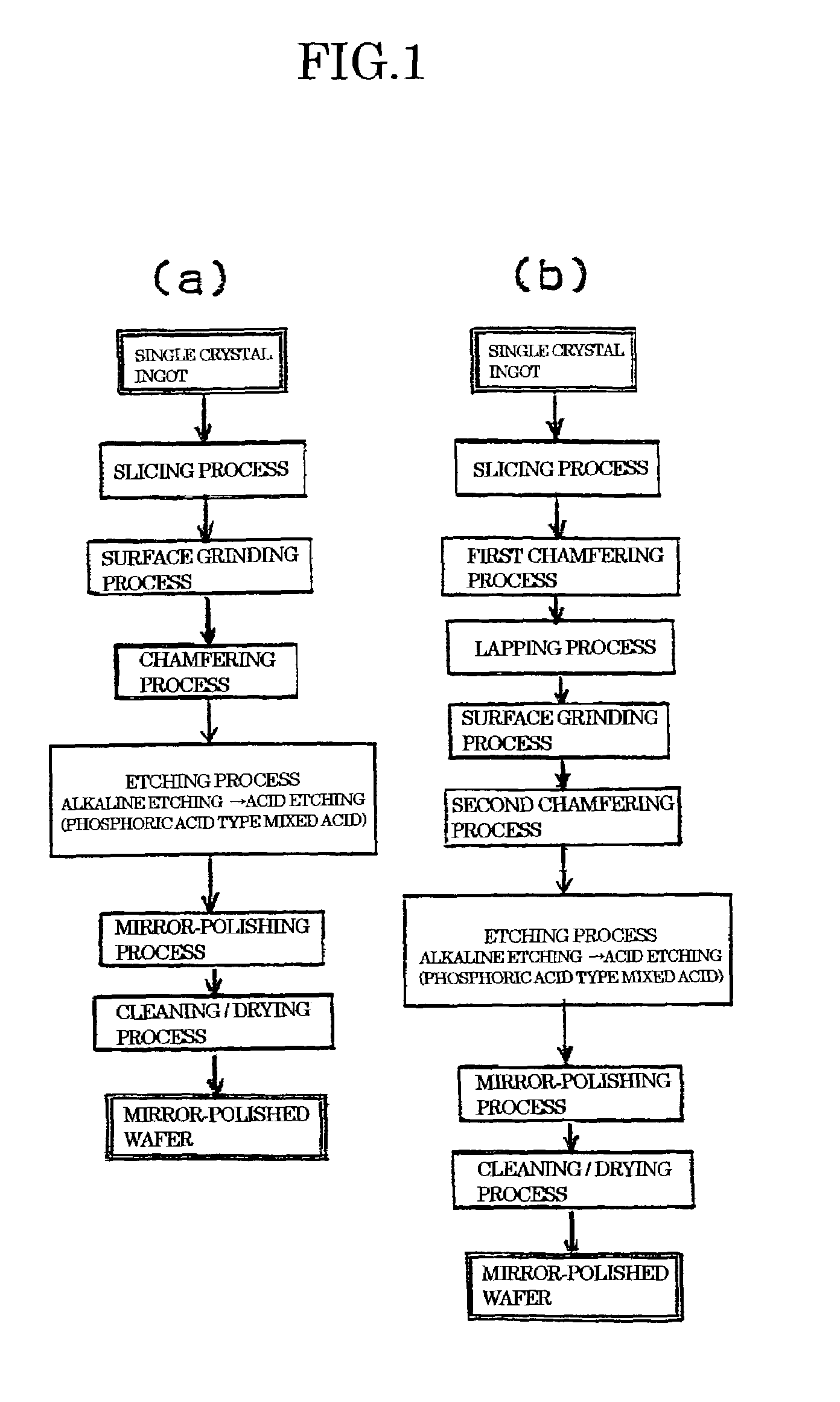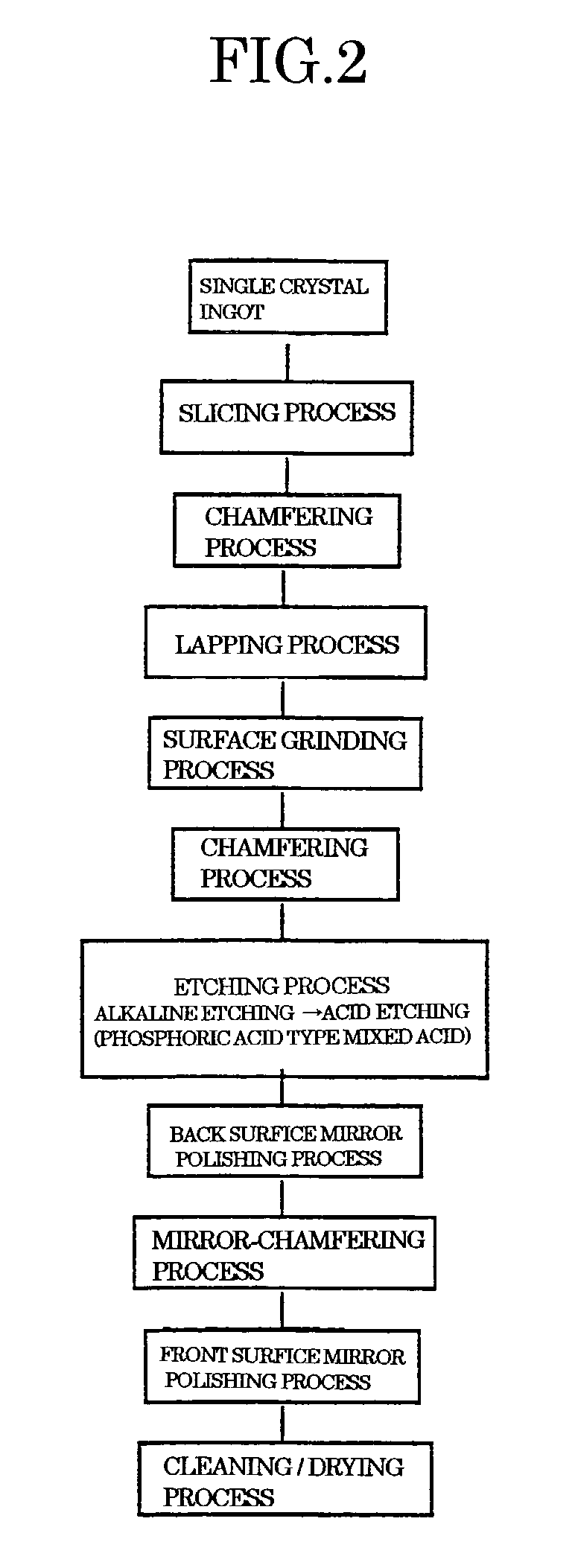Method for processing semiconductor wafer and semiconductor wafer
a technology of semiconductor wafers and processing methods, applied in the field of semiconductor wafers, can solve the problems of reducing the flatness of the wafer in proportion to the increase of the etching removal, the damage of the etching, so as to achieve the effect of less mechanical damage, easy production and high flatness
- Summary
- Abstract
- Description
- Claims
- Application Information
AI Technical Summary
Benefits of technology
Problems solved by technology
Method used
Image
Examples
example 1
[0131]As the result of the above consideration, in view of the pit depth, the surface condition, the etching rate, and the stability of the etchant, it was found that an etchant of which mixing ratio is hydrofluoric acid of 50% by weight:nitric acid of 70% by weight:phosphoric acid of 85% by weight=1:3:2, that is, an etchant of HF=6.6% by weight, HNO3=34.0% by weight, H3PO4=32.5% by weight, the retained material of H2O (26.9% by weight), and the meltage of silicon=19 g / L, was preferable. The following is the explanation of examples using this acid etchant.
[0132]The following etching treatment was performed for lapped wafers (lapping abrasive grain size: #1200) having a diameter of 200 mm (8 inches). TTV of this lapped wafer was about 0.8 μm.
[0133]First, the wafers were immersed in an NaOH aqueous solution having a concentration of 50% by weight at 85° C. for 450 seconds in order to perform alkali etching with a target etching amount being set to 20 μm on both sides in total. Subsequ...
example 2
[0147]Mirror-polished wafers were produced in the process as shown in FIG. 1(b), the wafers were prepared by slicing an ingot having a diameter of about 200 mm, the sliced wafers were subjected to first chamfering, then the wafers were lapped by using a lap slurry (lapping abrasive grain size: #1200), and by using the wafer (called lapped wafer), surface grinding was performed on the following conditions.
[0148]Surface grinding was performed by using an in-feed type single-side grinding apparatus, a spindle rotational speed was 5500 rpm, a wafer rotational speed was 7 rpm, and the feed rate of a grinding stone was 0.2 μm / sec. Then after, second chamfering was performed.
[0149]After this surface grinding, flatness (TTV) of the wafer was about 0.6 μm.
[0150]Next, as to alkaline etching, the wafers were immersed in an NaOH aqueous solution having a concentration of 50% by weight at 85° C. for 450 seconds in order to perform alkali etching with a target etching amount being set to 20 μm on...
example 3
[0173]Mirror-polished wafers were produced by the process as shown in FIG. 2. The wafers were obtained by slicing a single crystal rod (ingot) having a diameter of 200 mm and resistivity of 0.02 Ù·cm with a wire saw, and after a first chamfering, the wafers were subjected to lapping of 40 μm on both sides in total by using lapping slurry (lapping abrasive grain size: #1200). Next, replacing the above lapping slurry with lapping slurry of lapping abrasive grain size of #1500, the wafers were further subjected to lapping of 20 μm on both sides in total.
[0174]Subsequently, surface grinding was performed. The surface grinding was performed by using an in-feed type single-side grinding apparatus and using a grinding stone of #4000 at 10 μm on a single side of the wafers. The conditions of the surface grinding were that a spindle rotational speed was 5500 rpm, a wafer rotational speed was 7 rpm, and the feed rate of the grinding stone was 0.2 μm / sec. Then after, a second chamfering was pe...
PUM
| Property | Measurement | Unit |
|---|---|---|
| concentration | aaaaa | aaaaa |
| surface roughness | aaaaa | aaaaa |
| thickness | aaaaa | aaaaa |
Abstract
Description
Claims
Application Information
 Login to View More
Login to View More - R&D
- Intellectual Property
- Life Sciences
- Materials
- Tech Scout
- Unparalleled Data Quality
- Higher Quality Content
- 60% Fewer Hallucinations
Browse by: Latest US Patents, China's latest patents, Technical Efficacy Thesaurus, Application Domain, Technology Topic, Popular Technical Reports.
© 2025 PatSnap. All rights reserved.Legal|Privacy policy|Modern Slavery Act Transparency Statement|Sitemap|About US| Contact US: help@patsnap.com



